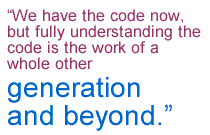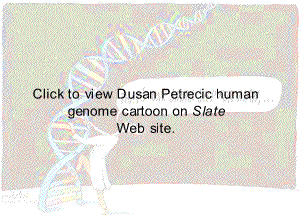
Filling the Holes in Draft Genome
As consortium scientists gear up to fill the holes they left in the draft sequence—a process that will take three years—Green worries about a possible loss of momentum due to release of a draft.
Moving methodically, consortium scientists had been meticulously exploring specific regions of the genome, with priority placed on those regions linked to particular diseases. The strategy was akin to creating a map of the United States by creating maps of all the terrain within each state, one state at a time.
Then along came Celera, and instead of waiting until 2003 to publish a complete and thorough map, the consortium began jumping from one state to the next without accounting for every bit of terrain. That way it could publish a complete—if not perfectly thorough—draft sequence in time to match Celera.
Olson says it was unfortunate that consortium leaders got caught in the "breathlessness that crept into the system" after Celera's arrival. On the other hand, "the draft provided lots of data that people are using today sooner than they would have."

Green believes changing strategies wasted money and produced little benefit—other than boosting the bottom line of Celera's sister company, Applied Biosystems.
That company produces the powerful machines scientists use to extract strands of DNA from cells. Celera deployed an armada of the devices right from the start, forcing the consortium to do the same if it wanted to keep up, says Green.
"Applied Biosystems is like an arms merchant that supplies both sides in a war," says Green.
Green believes publishing the draft poses an ongoing risk for the Human Genome Project. By creating the perception that the remaining work is a "mop-up operation," the draft may discourage some scientists from seeing the project through, he says.
If that's the case, why did consortium leaders dump their original strategy? "They were disturbed about the possibility that Celera would patent the whole genome," says Green.
And that's not all. "The stakes are pretty high here because people think there is a Nobel Prize involved," he says.
If so, it would slap Nobel book ends on a chapter of science that began when James Watson and Francis Crick won the 1962 prize for discovering the double-helix structure of DNA.

Toronto Star cartoonist Dusan Petricic provides another view on the subject of genome research. Click on the image to view it and many others on the Slate Web site.
Like shelves in a library, DNA molecules contain all of the books—or more precisely genes—necessary to create and sustain a particular organism. And every nucleus of every cell of every organism contains this library.
DNA molecules—a.k.a. chromosomes—resemble ladders with long spiral legs. The rungs consist of two interlocking chemical units called nucleotides. Together, the nucleotides form what are known as base pairs. Base pairs are combinations of either cytosine and guanine or adenine and thymine—referred to collectively as ACTGs.
Genes are sets of base pairs buried in the long and continuous sequence of ACTGs that comprise a DNA molecule. Each gene tells the cell how to make a specific protein—proteins being the catalyst for how cells ultimately develop and function.
Identify the sequence of all the ACTGs present within all of an organism's DNA and you've identified its genome. Identify its genome and you can begin identifying the genes responsible for health and disease—and developing gene-based tests and treatments.
Thanks to the foundation laid by Watson and Crick, all of those facts already were fodder for high school textbooks long before the Human Genome Project began. So why did it take scientists so long to assemble the human genome?
With 3 billion base pairs, the human genome is a mind-boggling procession of ACTGs—enough letters to fill more than 75,000 pages of a newspaper. Split between 24 chromosomes, the sets of base pairs range from a few hundred pairs to several thousand and the genes embedded in them often repeat or overlap.
What's more, the 30,000 to 35,000 genes hailed as "the human genome" represent only those sets of ACTGs that produce proteins. Like islands in a vast ocean, they are surrounded by a hundred times more "junk" DNA.
- Return to September 2001 Table of Contents